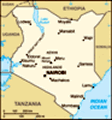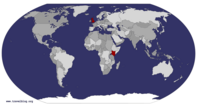Advertisement

 Tea Fields
Tea Fields
A green sea of tea fieldsTravel Blog entry 1: the Tea Farm (Kenya)
We drove up the dirt track passing the vast expanse of green fields that stretched out to the horizon. Here in stark contrast to the dry area of the savannah we had seen before, was a sea of rich green leaves with just a few field workers in the distance. We had come to visit the Kiambethu tea farm before continuing our journey to the Swara Plains game park and it seemed like the perfect choice for a lunchtime break. Not least because the farm seemed like a little bit of England had been blended with the Kenyan landscape.
Founded in 1918, the Kiambethu tea farm remains as a reminder of British influence in Kenya. The original owner of the farm, AB McDonnell was an Englishman who became the first person to plant tea commercially in Kenya. Since then McDonnell’s daughter Evelyn Mitchell, opened the land up for tourists to visit, providing an insight into settler life in Kenya and most importantly the production of tea, something irresistible to any true Brit or indeed the avid tea-lovers of the world.
At the end of the dirt track we got out

 Colobus Monkey
Colobus Monkey
A Mother Black and White Colobus Monkey clutches her new born baby.of the jeeps and were met with the sight of a rather genteel English home coupled with a neatly arranged lawn bursting with flowers. It was almost as if the jeeps had whisked us away to some stately English home. However three black and white reminders resting on the rooftop of the house brought me straight back to Kenya. Three Colobus monkeys were lounging on the chimney top in the lunchtime heat with the long white tails dangling over the side. And as if they had decided to greet us they soon burst into life leaping off the chimney and scrambling over the iron roof. Soon the whole house was immersed in a symphony of soft grunts and metallic clangs from whenever a monkey crawled over the roof.
The Black and White Colobus monkey or Guereza is the one of the only true herbivorous monkeys with a diet consisting entirely of plants and fruit and seeds. Such a diet seems fitting to the tree dwelling life style of the Guereza whose range stretches across much of central Africa and as far east as Ethiopia. However against its green habitat the colobus monkey sticks out like a sore thumb (although

 Feeding Colobus
Feeding Colobus
A Black and White Colobus Monkey having a quick snack.the Colobus monkey doesn’t actually have any thumbs). Predominantly black and white its unique monochrome coat makes the Colobus unique. It’s face is out lined with a fluffy white mane coupled with two white stripes running down it’s body, but it’s most striking feature is its long furry white tail which can grow between 70-90cm long and dangles behind the monkey as it leaps around it’s habitat.
We stood watching the Monkeys jump around the area as the current owners of the farm came out of the house. They walked over and introduced themselves while joining in with the lunchtime “monkey watching” session. Fiona Vernon and her husband Marcus are the third generation to live on the Kiambethu tea farm but they were still eager to share a few facts about the house and of course, the monkeys. With my camera at the ready, I was eager to get a good photo of the arboreal acrobats and soon I was running around the house trying to keep up with the animals’ impressive pace. It was a frustrating task. The Colobus monkey’s stayed near the top of the roof, scurrying along the ridge and then leaping from place to place. Then one Monkey dashed along a telephone wire near the house. This was my chance. A few people in the group and I hurried over to the corner of the house and gazed up into the surrounding trees. One Colobus monkey sat perched on a branch its arms wrapped tightly around its body. As we stood silent its arms unfolded to reveal something spectacular. It was a mother. A tiny baby Colobus clinged to its mother’s chest blanketed in the black furry arms of the mother Colobus. The baby Colobus was coated in pure white fur that looked just like sheep’s wool and stared back at us with its tiny little black eyes. Slowly I raised my camera up to my eyes at took a few quick photos. I was worried it would scare the mother but she seemed calm as she gazed back at us from the trees. One of the members of staff at the house came over to see what we were looking at.
“That’s last years baby,” he said, peering into the trees. “And now she’s having her own young.”
It appears there have been several generations of both people living at the tea farm and Colobus Monkeys as well.
Just as we walked back towards the house, we saw the rest of the group still staring at the house in excitement. Another of the staff members was holding a basket of fresh fruit and gave a piece to each person in our group. I walked over to my friend Tim who was holding a melon slice.
” Has lunch started then?” I asked
“ No” he replied laughing “ we’re going to give the fruit to the monkeys”
Once I heard the plan I was immediately excited, a close encounter as exotic as this couldn’t be missed and quickly I took a piece of watermelon from the basket as the staff member came past me. At the front of the house, two monkeys were dashing along the edge of the roof and I hurried over, fruit in hand, hoping the sweet sent would get the animals to stay still long enough. I stood under the end of the roof and looked up to find a rather curious Colobus staring right back at me. It appeared so suddenly I almost dropped the fruit in shock. As I peered into the animal’s shiny black eyes I saw two reflections of me on their surfaces. Then, just as I raised my hand with the watermelon slice, the Colobus grabbed it and dashed away. The whole encounter lasted less than a minute but it’s stayed with me ever since.
Although currently listed as “lower concern” by the IUCN (International Union for Conservation of Nature) as a species in terms of becoming endangered, The Colobus Monkey or Guereza is still threatened in the more remote parts of its range. Its attractive black and white coat has made it a target for hunting and as worldwide the deforestation continues the future of the Colobus monkey remains uncertain. Certainly at the Kiambethu tea farm the monkeys seem well looked after with fruit being dispensed to them but Fiona insisted that they weren’t seen as pets when I ask if any of the animals have names.
“ We don’t really like to think of them as pets ” She explained, “ We want them to stay as wild animals.”
Her point was fair enough, and I suppose its better to have a group of Colobus monkeys eating fruit then have them going through your bins everyday.
To finish our trip to the tea farm a few of the staff members agreed to take us on a tour around the area and in the mid afternoon we set of past the house and soon reached a path with a few pens beside it containing a herd of cattle. Although the cows grazing inside the wooden pens were oddly a breed that seemed more at home in rural England than in the Kenyan hills and I couldn’t see any big horned cattle like the ones that seemed to wander aimlessly in every place in Kenya we had been to before. It looked almost like a typical English farm had been stirred into the middle of Kenya. Half way down the path our guide stopped and began explaining the farm’s history. He revealed that the Colobus monkeys had made a home in the 6 acres of forestland that remained when the land was cleared for farming and that in they weren’t the only animals to live there. Species such as Porcupine also roamed the area and according to our guide once upon a time, even larger animals could be found.
“ There used to be leopards in the area” he stated “but not now. The last time I saw one was back in 1968”
Indeed something has disappeared in the area since the land was cleared but as long the Colobus monkeys continue to leap around the Kiambethu tea farm, something precious will remain for the future. It was clear to me from our visit that the Kiambethu tea farm is a place of co-existence both culturally with a clear mix of British and Kenyan lifestyles, but also environmentally. Perhaps if man and nature are able to live together peacefully at this farm then maybe the same could be true on others across the world.
Advertisement
Tot: 0.174s; Tpl: 0.032s; cc: 9; qc: 54; dbt: 0.0779s; 1; m:domysql w:travelblog (10.17.0.13); sld: 1;
; mem: 1.2mb









Nellienoos
Ornella Hulbert
Travel writing!
I saw your aim so I am very interested in how you go about it! So far so good. I feel as if I'm there and loving the monkeys, my only niggly thing is who is we? And were did you come from to end up in this wonderful country home surrounded by Kenya? I can't wait to read more!!!